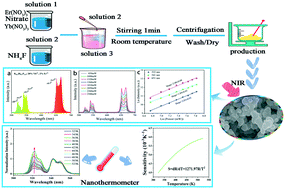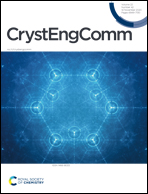Room-temperature ultrafast synthesis, morphology and upconversion luminescence of K0.3Bi0.7F2.4:Yb3+/Er3+ nanoparticles for temperature-sensing application†
Abstract
An ultrafast route at room temperature has been developed for the first time to synthesize lanthanide ion (Yb3+/Er3+)-activated K0.3Bi0.7F2.4 fluorescent nanoparticles and hold the potential to be applied in luminescent temperature sensors. In addition, the crystal structure and morphology of the K0.3Bi0.7F2.4 nanoparticles prepared at different reaction conditions were studied in detail for the first time, including the reaction time and different mole ratios of Bi source and NH4F. Moreover, Yb3+/Er3+ doped in the K0.3Bi0.7F2.4 matrix using a luminescent thermometer based on the fluorescence intensity ratio technology was also investigated. Additionally, K0.3Bi0.7F2.4:Yb3+/Er3+ revealed excellent up-conversion luminescence performance, and the up-conversion mechanisms of samples are affirmed according to the up-conversion emission intensity as a function of the pump power density. Simultaneously, the optical thermometric performance of the samples was investigated in the temperature range of 323–523 K to indagate the temperature sensor performance. Significantly, the maximum sensor sensitivity of the studied nanoparticles were 0.0058 K−1 (Sa) at 523 K and 1.08 K−1 (Sr) at 323 K, which indicates that K0.3Bi0.7F2.4:20%Yb3+/2%Er3+ fluorescent nanoparticles can be exploited as a promising luminescent thermometer.

- This article is part of the themed collection: Editor’s Collection: Rare Earth Materials


 Please wait while we load your content...
Please wait while we load your content...